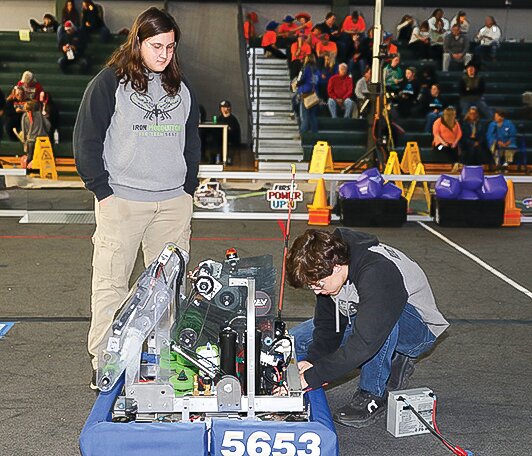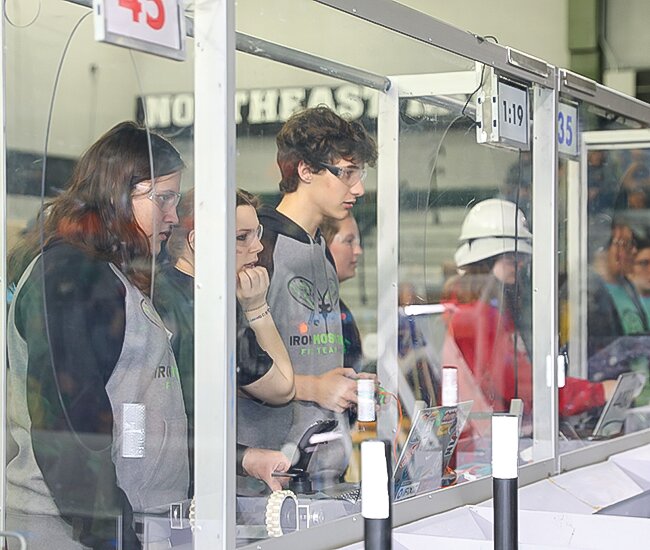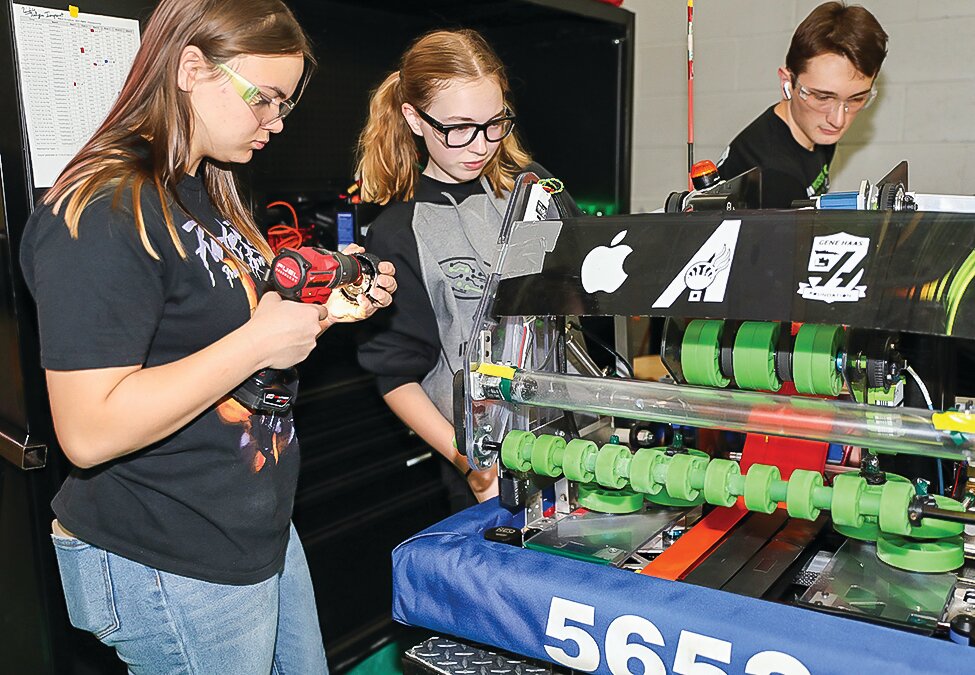Support the Timberjay by making a donation.
Northeast Range hosts statewide robotics meet
BABBITT— Creative brains were in high gear here this past Saturday as Northeast Range High School hosted its first-ever Northern Minnesota Robotics Conference (NMRC) tournament— and the …
This item is available in full to subscribers.
Attention subscribers
To continue reading, you will need to either log in to your subscriber account, below, or purchase a new subscription.
Please log in to continue |
Northeast Range hosts statewide robotics meet
BABBITT— Creative brains were in high gear here this past Saturday as Northeast Range High School hosted its first-ever Northern Minnesota Robotics Conference (NMRC) tournament— and the home team, the Iron Mosquitos, had an exceptional outing winning the tournament’s Impact Award. At the same time, the team’s lead mentor, teacher Ryan Lindsay, was recognized as the conference’s Mentor of the Year.
The tournament, held Oct. 27-28, was a pre-season event, before the FIRST Robotics League play that is hosted in larger venues like the DECC or Williams Arena, gets underway in the winter. The teams participating were using their robot builds from last school year’s season, for a challenge called “Charged Up.”
Lindsay was a bit in awe at the crew responsible for setting up the gym for the competition. A professional crew from NLfx, a DJ and audio company, did all the electronics setup, including the large screen broadcasting the action. Protective flooring was installed in the gym, and the hundreds of cords were all safely covered with rubber matting. The arena area was installed in the center of the gym, and each team had a small pit area where they did last minute repairs along with between match tune-ups and battery changes. The pit is just about big enough to fit the robot and three team members, said Lindsay.
The gym itself was almost unrecognizable, and just barely big enough to fit all the action.
“This is the busiest I’ve ever seen our gym,” Lindsay said. NER students all got a chance to spend time watching the action on Friday, but even after school, the bleachers were full of friends and family watching the event. The Iron Mosquitos were the only Iron Range team at the tournament, with most of the teams coming in from northwestern and north-central Minnesota. Some newer robotic teams have been forming in the area, Lindsay said, including North Woods School, Mesabi East, and Chisholm/Hibbing.
This year’s Mosquitos came to the floor with plenty of experience. The team is based at NER but does include members from other area schools. “We only lost one senior this year,” said Lindsay, though some team members left because they were able to join new teams starting up at their local school.
The team’s drive team leaders were Greyson Reichensperger, Matt Bock, Ian Sunsdahl, and Hailey Lindquist. Other key returning team members are Tuuli Koivisto, Eva Morgan, and Natalie Backe, Lindsay said.
The team finished the first day of competition in fifth place (out of 17 teams), but the next day their hard work paid off. The team was still in fifth-place after the qualification rounds on Saturday morning. The top four ranked teams get to choose two other teams to partner with in the championship round. The Mosquitos were chosen to be part of one of these teams, and their alliance finished in the top scoring spot, the first time the Mosquitos have won a championship banner. Last year the team was in the runner-up spot at the NMRC.
The success of last year’s team, which earned a spot at the World Championship tournament last spring, definitely has had an impact on student interest, said Lindsay.
“I think we will double our team’s size this year,” he said. The team has also been doing outreach with upper elementary students as well as workshops at the Bois Forte Boys and Girls Clubs this summer. In addition to the competition robot, the team has been tasked with creating a robotic “Olaf the Snowman” for Ely High School’s production of Frozen this winter.
“It has to dance and have different expressions,” he said, “we are going to be building a snowman.”
Lindsay said many students think robotics is just computer coding and constructing the metal and electronics in the shop.
“But it also depends on student’s who are interested in art and design,” he said. “It is fun to tap into these students’ passions also.”
“The team is pretty independent during the competition,” said Lindsay, who was taking some time out of the rather noisy gym, “but they do sometimes come find me with questions.”
The team had a few battery-related challenges on Friday, after switching out a dead battery for one that hadn’t been fully recharged. The small wheels the robot relied on also seemed to be easily damaged, and in the pit between matches, team members were busy repairing and reattaching them.
Greyson Reichensperger, an experienced team member, was pretty happy with his team’s performance on Friday.
“We did our job very nicely,” he said after a successful late afternoon match. Greyson could be found helping in all aspects of the team’s work, hauling the robot on and off the tournament arena, coaching other team members who were replacing robot parts, and helping steer the robot during the match itself.
Tournament action
With 17 teams participating, the NER school gym was crammed wall to wall with robotic teams and their gear, electronic equipment, sound and video equipment, along with the dozens and dozens of volunteers needed to make the competition move smoothly.
Some volunteers were in charge of ensuring teams were able to move their robots on and off the center staging area without bumping into other teams. Others kept the edges of the playing area clear so team members could easily move back and forth.
The individual matches only last two-and-a-half minutes, and on Friday, each team played at least nine matches. Matches include “alliances” of three teams, designated red or blue, competing against another alliance of three teams. Each team earns points for scoring game pieces, as well as hitting other milestones. Points earned in each match are added up at the end of the day, to determine the top teams.
Each match begins with a 15-second autonomous period, during which time alliance robots operate only on pre-programmed instructions to score points by doing assigned tasks.
In the final two minutes and 15 seconds of the match, drivers take control of the robots and score points by continuing to retrieve and score their game pieces onto the grid and docking on or engaging with their charge station.
Jennifer Engle, whose team had traveled to Babbitt from Alexandria, was happy to be an adult volunteer. Last year, her school hosted this competition.
“We had so many volunteers,” she said, and she was happy to return the favor.
Engle first coached robotics at Vermilion Country School, almost 10 years ago. Her team was staying at Grand Ely Lodge and she bumped into one of her former VCS students from the team, Jacob Karasti, who works at the lodge.
Engle said she has made friends all across the state through robotics coaching. She especially likes the support from other teams and coaches, along with the NMRC organization.
“More kids are seeing STEM and robots now,” she said.
Engle’s team has become a family affair. Her parents often travel with her to tournaments and help out. “They love being with all the kids,” she said.
Sponsors of the event included the Gene Haas Foundation, DigiKey, PMMI, Ali, Aagard, NLfx, Walmart, Minnesota Army National Guard, STEM Alliance, Western Bank, Visto’s Trailer Sales. Local sponsors included the Ely Rotary Club, the Applied Learning Institute, as well as Northeast Range School.











